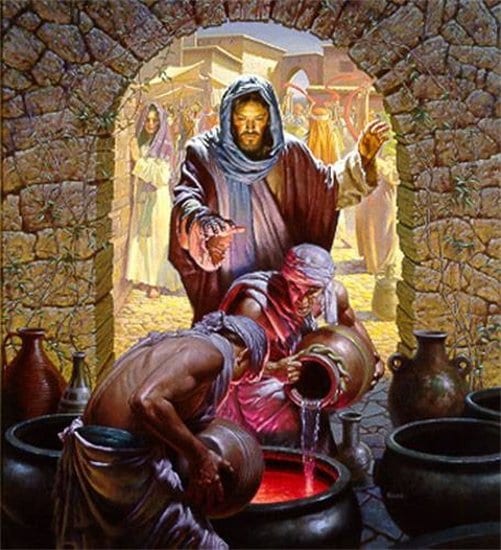
The Wedding in Cana has traditionally been called one of the “three Epiphanies” of Christ; the other two are the Visitation of the Magi and the Baptism of the Lord. In each of these events, Jesus is manifested in one way or another as the Messiah and the Son of God. Undoubtedly, the miracle of the wedding in Cana, due to its many symbolisms, is one of the richest sources of reflection for personal prayer.
If we look closely at the first two chapters of the Gospel of John, there are a total of seven days leading to the miracle at the wedding feast in Cana. On the first day (Jn1:19-28), John the Baptist directed attention away from himself and said, “There is one among you whom you do not recognize, the one who is coming after me, whose sandal strap I am not worthy to untie (Jn1:26-27).” On the second day (Jn1:29-34), John pointed to Jesus and said, “Behold the Lamb of God who takes away the sin of the world (Jn1:29).” On the third day (Jn1: 35-42), two disciples of John left him and followed Jesus. One of them was Andrew; he then went to find his brother Simon and brought him to Jesus. On the fourth day (Jn1:43-51), Jesus found Philip and Philip brought Nathanael to Jesus. After three more days, Jesus performed His first miracle at the wedding feast in Cana. There, the glory of Jesus was revealed and the disciples began to believe in Him (Jn2:11).
What is the significance of the “seven” days? Many bible commentators agree that the number “seven” signifies perfection or completeness. The number seven appears many times in the bible, but the classic example is that God created the world in six days and rested on the seventh; i.e., the whole work of creation would not be complete without the seventh day of rest. In a way, the first miracle of Jesus in Cana marks the completion of the epiphany events and inaugurates the beginning of His public ministry.
In addition, the miracle at Cana which Jesus performed “on the third day” (Jn2:1), corresponds to God revealing Himself “on the morning of the third day” in the Book of Exodus (Ex19:16). Just as the glory of God was revealed to the Israelites at Mount Sinai, so also the glory of Christ was revealed to His disciples at Cana.
Jesus’ reply: “My hour has not yet come” can be taken to mean that it was not yet time for Him to be known publicly as the Messiah. We see the same thing happen several times in the Gospels, wherein Jesus warns His disciples and the people whom He had just healed not to tell anyone, because His hour has not yet come. Hence, only a select few were made aware of the miracle at Cana: Mary, the disciples and the servants. Even the head steward, the bride and the groom, and the other guests were oblivious of the miracle that Jesus had just performed.
With all its subtle yet deep and meaningful points, one important insight from the miracle at Cana is that God works many miracles in the world that is not made public, and yet the people who witness these miracles are changed forever.